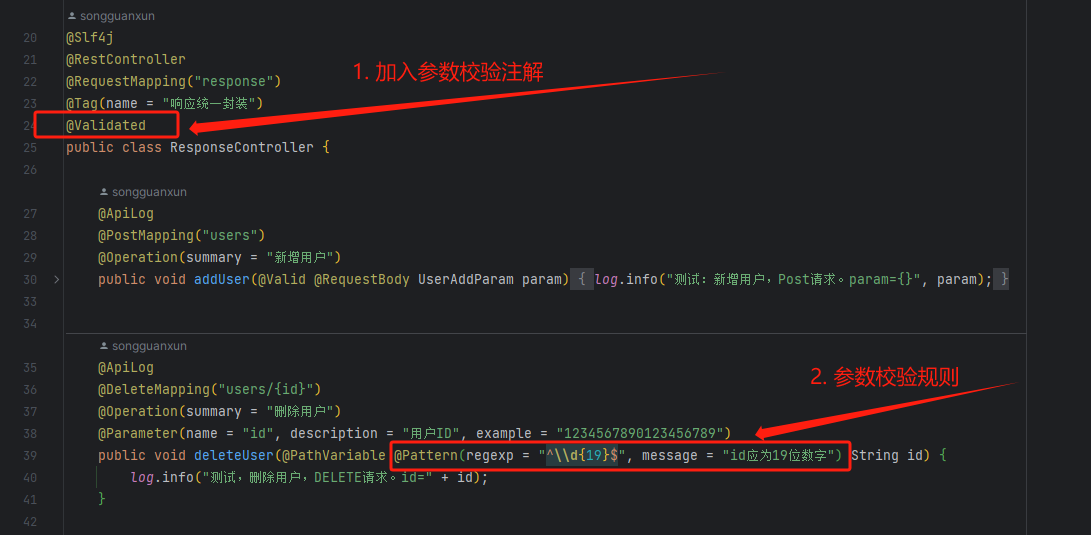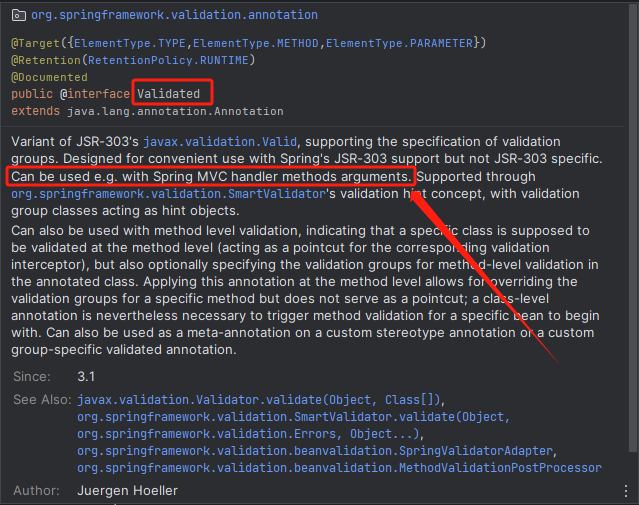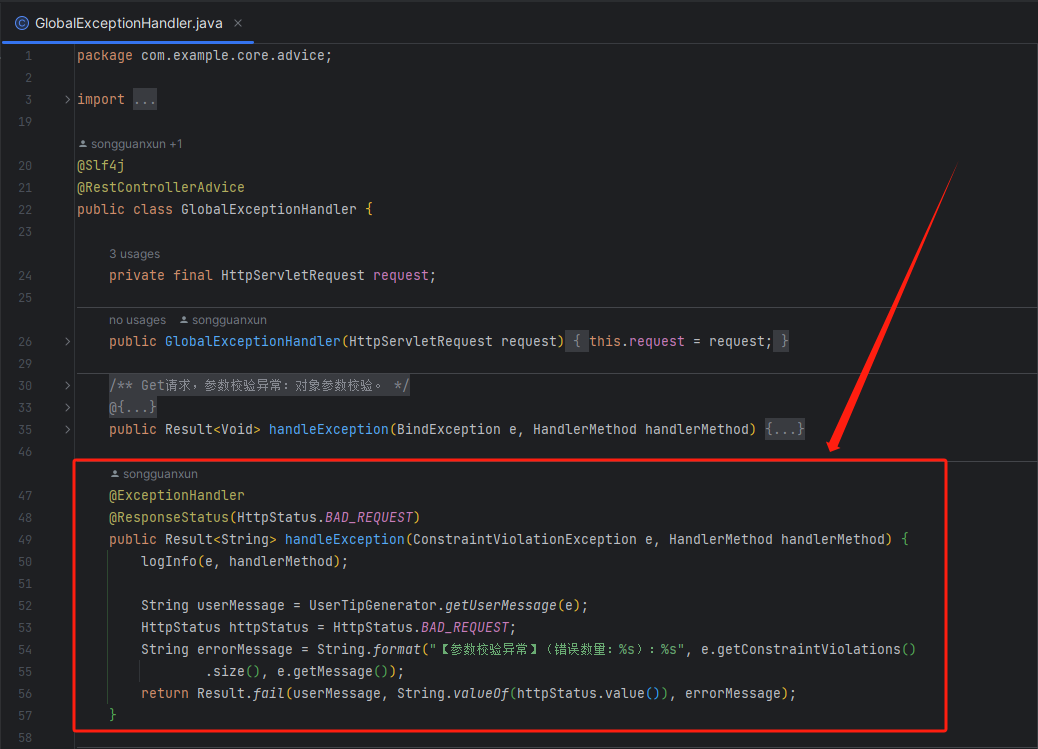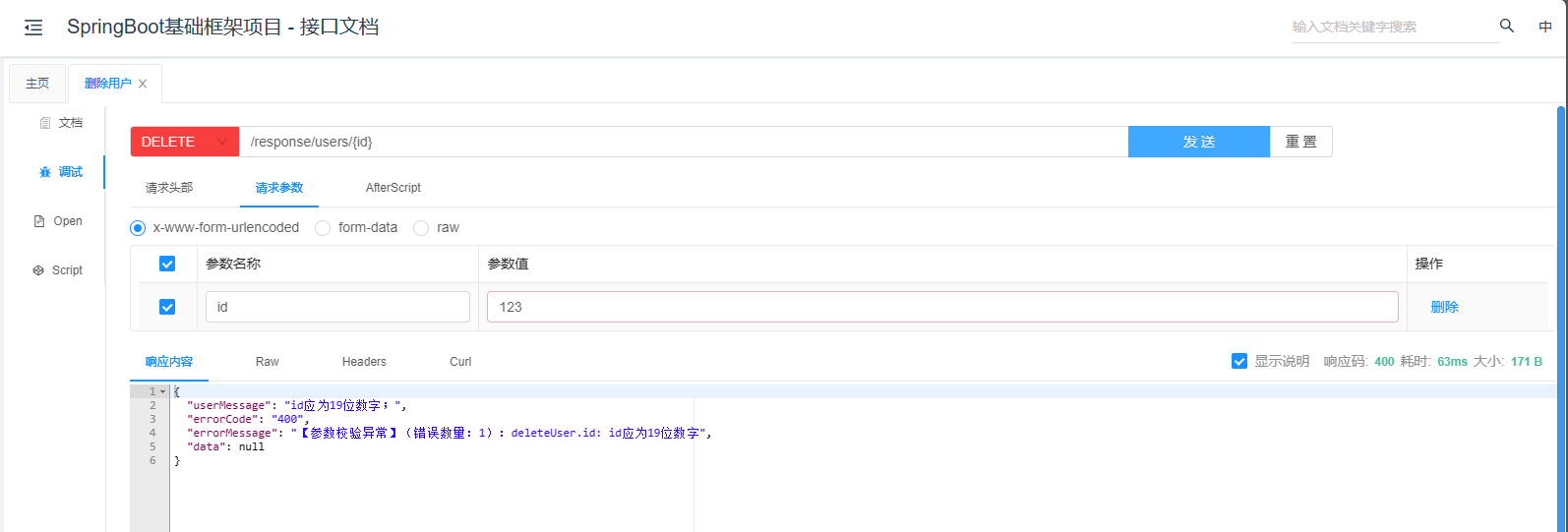路径参数@PathVariable,参数校验:@Validated(Controller上)+@Pattern
发布时间:2023年12月21日
说明
对 路径参数 进行合法性校验。

主要使用场景为:校验 id 的长度,是否符合要求。
如果id长度不对,说明一定找不到此id对应的数据,也就不需要去操作数据库了,直接在接口层就拦截掉无效请求。
比如:通过ID查询一条记录、通过ID删除一条记录、通过ID修改一条记录,都是通过id来找到这条记录的,都应该对id进行合法性校验。
校验逻辑
有效格式
本文中的例子,是对删除用户接口的用户ID参数进行校验,此参数是路径参数,其正确格式应该为19位数字(雪花算法生成的ID)。
核心代码
开启校验,主要包含两个注解:
- 开启校验的注解:
@Validated - 校验格式的注解:
@Pattern
异常统一处理:
- ConstraintViolationException
校验不通过会抛出异常 ConstraintViolationException,需要在异常统一处理中,加入对应的处理逻辑,向前端返回适当的响应。
开启校验的注解:@Validated
@Slf4j
@RestController
@RequestMapping("response")
@Tag(name = "响应统一封装")
@Validated
public class ResponseController {
// 接口代码,省略。。。
}
@Validated,是 @Valid 的变体,本例需要对接口方法的参数直接进行校验,所以使用 @Validated(经过测试,使用@Valid无效,不能开启校验)。
@Validated 官方解释如下:
JSR-303的javax.validation.Validity的变体,支持验证组的规范。
可以与Spring MVC处理程序方法参数一起使用。

校验格式的注解:@Pattern
使用位置为:需要校验的路径参数前;
包含的内容有:参数的校验格式 和 校验不通过时的提示语。
@ApiLog
@DeleteMapping("users/{id}")
@Operation(summary = "删除用户")
@Parameter(name = "id", description = "用户ID", example = "1234567890123456789")
public void deleteUser(@PathVariable @Pattern(regexp = "^\\d{19}$", message = "id应为19位数字") String id) {
log.info("测试,删除用户,DELETE请求。id=" + id);
}
异常统一处理:ConstraintViolationException
@ExceptionHandler
@ResponseStatus(HttpStatus.BAD_REQUEST)
public Result<String> handleException(ConstraintViolationException e, HandlerMethod handlerMethod) {
logInfo(e, handlerMethod);
String userMessage = UserTipGenerator.getUserMessage(e);
HttpStatus httpStatus = HttpStatus.BAD_REQUEST;
String errorMessage = String.format("【参数校验异常】(错误数量:%s):%s", e.getConstraintViolations()
.size(), e.getMessage());
return Result.fail(userMessage, String.valueOf(httpStatus.value()), errorMessage);
}
不进行异常处理的接口响应

异常统一处理后的接口响应

异常统一处理代码

完整示例代码
接口校验
package com.example.web.response.controller;
import com.example.core.log.annotation.ApiLog;
import io.swagger.v3.oas.annotations.Operation;
import io.swagger.v3.oas.annotations.Parameter;
import io.swagger.v3.oas.annotations.tags.Tag;
import lombok.extern.slf4j.Slf4j;
import org.springframework.validation.annotation.Validated;
import org.springframework.web.bind.annotation.DeleteMapping;
import org.springframework.web.bind.annotation.PathVariable;
import org.springframework.web.bind.annotation.RequestMapping;
import org.springframework.web.bind.annotation.RestController;
import javax.validation.constraints.Pattern;
@Slf4j
@RestController
@RequestMapping("response")
@Tag(name = "响应统一封装")
@Validated
public class ResponseController {
@ApiLog
@DeleteMapping("users/{id}")
@Operation(summary = "删除用户")
@Parameter(name = "id", description = "用户ID", example = "1234567890123456789")
public void deleteUser(@PathVariable @Pattern(regexp = "^\\d{19}$", message = "id应为19位数字") String id) {
log.info("测试,删除用户,DELETE请求。id=" + id);
}
// 其他接口省略 ...
}
异常统一处理
package com.example.core.advice;
import com.example.core.advice.util.ErrorMessageGenerator;
import com.example.core.advice.util.UserTipGenerator;
import com.example.core.model.BusinessException;
import com.example.core.model.Result;
import lombok.extern.slf4j.Slf4j;
import org.springframework.http.HttpStatus;
import org.springframework.validation.BindException;
import org.springframework.validation.FieldError;
import org.springframework.web.bind.annotation.ExceptionHandler;
import org.springframework.web.bind.annotation.ResponseStatus;
import org.springframework.web.bind.annotation.RestControllerAdvice;
import org.springframework.web.method.HandlerMethod;
import javax.servlet.http.HttpServletRequest;
import javax.validation.ConstraintViolationException;
import java.util.List;
@Slf4j
@RestControllerAdvice
public class GlobalExceptionHandler {
private final HttpServletRequest request;
public GlobalExceptionHandler(HttpServletRequest request) {
this.request = request;
}
/**
* Get请求,参数校验异常:对象参数校验。
*/
@ExceptionHandler
@ResponseStatus(HttpStatus.BAD_REQUEST)
public Result<Void> handleException(BindException e, HandlerMethod handlerMethod) {
logInfo(e, handlerMethod);
List<FieldError> fieldErrors = e.getFieldErrors();
String userMessage = UserTipGenerator.getUserMessage(fieldErrors);
String errorMessageCore = ErrorMessageGenerator.getErrorMessage(fieldErrors);
HttpStatus httpStatus = HttpStatus.BAD_REQUEST;
String errorMessage = String.format("【参数校验异常】(错误数量:%s):%s", e.getErrorCount(), errorMessageCore);
return Result.fail(userMessage, String.valueOf(httpStatus.value()), errorMessage);
}
@ExceptionHandler
@ResponseStatus(HttpStatus.BAD_REQUEST)
public Result<String> handleException(ConstraintViolationException e, HandlerMethod handlerMethod) {
logInfo(e, handlerMethod);
String userMessage = UserTipGenerator.getUserMessage(e);
HttpStatus httpStatus = HttpStatus.BAD_REQUEST;
String errorMessage = String.format("【参数校验异常】(错误数量:%s):%s", e.getConstraintViolations()
.size(), e.getMessage());
return Result.fail(userMessage, String.valueOf(httpStatus.value()), errorMessage);
}
/**
* 业务异常处理
*/
@ExceptionHandler
@ResponseStatus(HttpStatus.BAD_REQUEST)
public Result<Void> handleException(BusinessException e, HandlerMethod handlerMethod) {
logInfo(e, handlerMethod);
return Result.fail(e.getUserMessage(), e.getErrorCode(), e.getErrorMessage());
}
private void logInfo(Exception e, HandlerMethod handlerMethod) {
String message = getLogMessage(e, handlerMethod);
log.info(message, e);
}
private String getLogMessage(Exception e, HandlerMethod handlerMethod) {
String exceptionName = e.getClass()
.getName();
String requestMethod = request.getMethod();
String url = request.getRequestURI();
String className = handlerMethod.getBean()
.getClass()
.getName();
String methodName = handlerMethod.getMethod()
.getName();
return String.format("\n接口:[%s:%s]\n异常名称:[%s]\n出现异常的方法:[%s.%s]\n异常信息:\n%s", requestMethod, url, exceptionName, className, methodName, e.getMessage());
}
}
package com.example.core.advice.util;
import org.springframework.util.CollectionUtils;
import org.springframework.validation.FieldError;
import javax.validation.ConstraintViolation;
import javax.validation.ConstraintViolationException;
import java.util.List;
import java.util.Set;
/**
* 用户提示生成器。
*
* @author songguanxun
* @date 2023-8-24
*/
public class UserTipGenerator {
/**
* 获取用户提示(参数校验异常时)
*/
public static String getUserMessage(List<FieldError> errors) {
StringBuilder stringBuilder = new StringBuilder();
errors.forEach(error -> {
String defaultMessage = error.getDefaultMessage();
String numberFormatExceptionName = NumberFormatException.class.getName();
if (defaultMessage != null && defaultMessage.contains(numberFormatExceptionName)) {
String message = String.format("数字格式异常,当前输入为:[%s]", error.getRejectedValue());
stringBuilder.append(message)
.append(";");
} else {
stringBuilder.append(defaultMessage)
.append(";");
}
});
return stringBuilder.toString();
}
public static String getUserMessage(ConstraintViolationException e) {
Set<ConstraintViolation<?>> sets = e.getConstraintViolations();
if (CollectionUtils.isEmpty(sets)) {
return "";
}
StringBuilder sb = new StringBuilder();
sets.forEach(error -> sb.append(error.getMessage())
.append(";"));
return sb.toString();
}
}
校验效果
成功

失败

文章来源:https://blog.csdn.net/sgx1825192/article/details/134581861
本文来自互联网用户投稿,该文观点仅代表作者本人,不代表本站立场。本站仅提供信息存储空间服务,不拥有所有权,不承担相关法律责任。 如若内容造成侵权/违法违规/事实不符,请联系我的编程经验分享网邮箱:chenni525@qq.com进行投诉反馈,一经查实,立即删除!
本文来自互联网用户投稿,该文观点仅代表作者本人,不代表本站立场。本站仅提供信息存储空间服务,不拥有所有权,不承担相关法律责任。 如若内容造成侵权/违法违规/事实不符,请联系我的编程经验分享网邮箱:chenni525@qq.com进行投诉反馈,一经查实,立即删除!
最新文章
- Python教程
- 深入理解 MySQL 中的 HAVING 关键字和聚合函数
- Qt之QChar编码(1)
- MyBatis入门基础篇
- 用Python脚本实现FFmpeg批量转换
- RPC 框架之Thrift入门(一)
- 基于SSM+SpringBoot+Vue的高校心理教育辅导设计与实现系统(附论文)
- 深入探索Qt 6.3:全面了解新特性及应用技巧
- Nginx 主动检查 被动检查
- 【JavaWeb后端开发-第六章(3)】SpringBootWeb案例—登录认证
- LeetCode[105] 从前序与中序遍历序列构造二叉树
- 荣誉 | 第七在线(7thonline)荣获STIF2023年度数智化创新典范奖会
- 数据操作——Column 对象
- 【创作活动】ChatGPT 和文心一言哪个更好用?
- WPF入门到跪下 第十章 MVVMToolkit